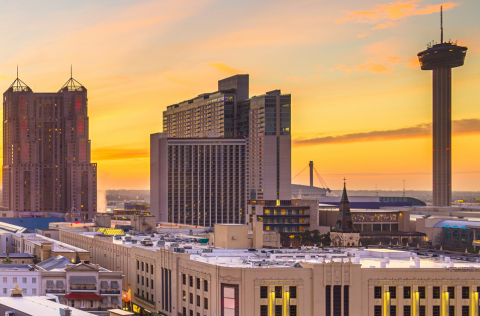 An urban heat island occurs when a city's temperature is much warmer than nearby rural areas. The difference in temperature has to do with how well the surfaces in each environment absorb and hold heat.
An urban heat island occurs when a city's temperature is much warmer than nearby rural areas. The difference in temperature has to do with how well the surfaces in each environment absorb and hold heat.
Heat islands can:
- have a negative impact on health.
- increase energy costs.
- create poor air quality.
Collaboration Strategies
Metro Health and other City departments work together to develop Urban Heat Island (UHI) mitigation strategies. These strategies include:
- urban planning innovations
- public health interventions
- community engagement
Reduce the Impact of UHIs
Reducing the heat island effect can help reduce negative impacts. You can help reduce urban heat island temperatures by taking action.
- Plant trees and vegetation to increase shade around your home.
- Create shade structures.
- Install light-colored roofing shingles.
- Use energy-efficient appliances and equipment.
Causes of Urban Heat Islands
City buildings, roads and structures absorb and release heat more than natural landscapes. Forests and water bodies are examples of cooler landscape areas. Urban areas, where there is little vegetation can become "islands" of higher temperatures.
- Impervious Surfaces
- Asphalt, concrete, and other materials used in urban areas absorb and hold heat.
- Lack of Vegetation
- Urban areas often have fewer trees and green spaces, reducing shade and cooling.
- Heat Generated from Human Activities
-
Sources of human-generated waste heat that can contribute to heat island effects include:
- vehicles
- air-conditioning units
- buildings
- industrial facilities
- Urban Design
- Building density, layout, and materials influence the intensity of the urban heat island effect. In heavily developed areas, surfaces and structures obstructed by neighboring buildings tend to trap heat. Cities with many narrow streets and tall buildings become urban canyons, which can block natural wind flow that would normally bring cooling effects.
Impact on Public Health
The urban heat island effect can pose significant health risks. This includes heat-related illnesses, worsen respiratory conditions, mental health impacts and social disparities.
- Young children are more susceptible to extreme heat.
- Older adults may have limited mobility and access to resources.
- People with underlying medical conditions including:
- asthma
- high blood pressure
- heart disease
- Low-income residents may have a lack of air conditioning and inadequate housing.
- Outdoor workers have higher heat exposure.
Mitigation Strategies
Strategies include:
- Increasing green spaces
- Promoting cool pavements
- Cool walls and roofs
- Implementing smart urban planning practices
- Enhancing heat emergency preparedness
- Increase the number of areas with shade around your home or business
- Plant trees and other vegetation
- Use energy-efficient appliances
- Install light-colored roofing shingles
Urban Heat Island Brochure(PDF, 2MB)
Metro Health is dedicated to educating the community on reducing the health impacts of UHI's. By understanding the causes and consequences of UHIs, and implementing effective mitigation strategies, we aim to create healthier, more resilient communities in San Antonio.
Metro Health is committed to educating the community on the ways to reduce the health impacts of UHI's.
Resources
Explore our resources to learn more about urban heat islands and how you can get involved in mitigating their impact on public health in San Antonio.
Local
Federal
For Children